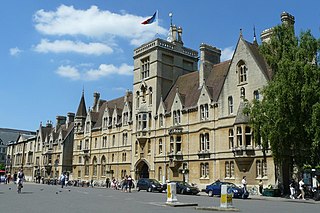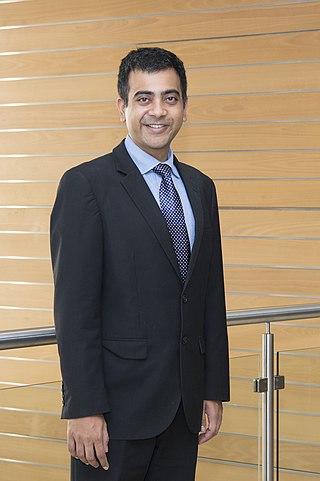
An engineering technologist is a professional trained in certain aspects of development and implementation of a respective area of technology. An education in engineering technology concentrates more on application and less on theory than does an engineering education. Engineering technologists often assist engineers; but after years of experience, they can also become engineers. Like engineers, areas where engineering technologists can work include product design, fabrication, and testing. Engineering technologists sometimes rise to senior management positions in industry or become entrepreneurs.

The Institution of Engineering and Technology (IET) is a multidisciplinary professional engineering institution. The IET was formed in 2006 from two separate institutions: the Institution of Electrical Engineers (IEE), dating back to 1871, and the Institution of Incorporated Engineers (IIE) dating back to 1884. Its worldwide membership is currently in excess of 158,000 in 153 countries. The IET's main offices are in Savoy Place in London, England, and at Michael Faraday House in Stevenage, England.
The Engineering Council is the UK's regulatory authority for registration of Chartered and Incorporated engineers and engineering technician. The Engineering Council holds the national registers of over 228,000 Engineering Technicians (EngTech), Incorporated Engineers (IEng), Chartered Engineers (CEng) and Information and Communications Technology Technicians (ICTTech). The Engineering Council is also responsible for establishing and upholding globally acknowledged benchmarks of professional competence and ethical conduct, which govern the award and retention of these titles. This guarantees that employers, government bodies, and the broader society, both within the UK and abroad, can place their trust in the expertise, experience, and dedication of engineers and technicians who are professionally registered with the Engineering Council.
The architectural technologist, also known as a building technologist, provides technical building design services and is trained in architectural technology, building technical design and construction.
The Sydney Accord is an international mutual recognition agreement for qualifications in the fields of engineering technology.
Rehabilitation engineering is the systematic application of engineering sciences to design, develop, adapt, test, evaluate, apply, and distribute technological solutions to problems confronted by individuals with disabilities. These individuals may have experienced a spinal cord injury, brain trauma, or any other debilitating injury or disease. Functional areas addressed through rehabilitation engineering may include mobility, communications, hearing, vision, and cognition, and activities associated with employment, independent living, education, and integration into the community.
Certified engineering technologist (CET) is a Canadian professional certification awarded on the basis of academic qualification and work experience. Abbreviated as C.E.T., most Canadian provincial engineering and applied science technology associations offer this certification. Certification is voluntary and does not represent a provincial regulatory requirement or a statutory required license.

The Institute of Marine Engineering, Science and Technology (IMarEST) is the international membership body and learned society for marine professionals operating in the spheres of marine engineering, science, or technology. It has registered charity status in the UK. It has a worldwide membership of 21,000 individuals based in over 128 countries. The institute is a member of the UK Science Council and a licensed body of the Engineering Council UK.

An engineering technician is a professional trained in skills and techniques related to a specific branch of technology, with a practical understanding of the relevant engineering concepts. Engineering technicians often assist in projects relating to research and development, or focus on post-development activities like implementation or operation.

Electrical/Electronics engineering technology (EET) is an engineering technology field that implements and applies the principles of electrical engineering. Like electrical engineering, EET deals with the "design, application, installation, manufacturing, operation or maintenance of electrical/electronic(s) systems." However, EET is a specialized discipline that has more focus on application, theory, and applied design, and implementation, while electrical engineering may focus more of a generalized emphasis on theory and conceptual design. Electrical/Electronic engineering technology is the largest branch of engineering technology and includes a diverse range of sub-disciplines, such as applied design, electronics, embedded systems, control systems, instrumentation, telecommunications, and power systems.

Engineering education is the activity of teaching knowledge and principles to the professional practice of engineering. It includes an initial education, and any advanced education and specializations that follow. Engineering education is typically accompanied by additional postgraduate examinations and supervised training as the requirements for a professional engineering license. The length of education, and training to qualify as a basic professional engineer, is typically five years, with 15–20 years for an engineer who takes responsibility for major projects.
The Engineering Council of South Africa (ECSA) is the statutory body for engineering profession in South Africa. Its functions are to accredit the engineering programs and to register the engineering professionals in specified categories throughout the country.
Dr. Bernard Price, OBE, was the founding Chief Engineer and later General Manager of the Victoria Falls and Transvaal Power Company in South Africa between 1911 and 1936.
Hendrik Johannes van der Bijl FRS was a South African electrical engineer and industrialist and is regarded as one of the greatest South Africans for his contribution to the country's development. He was the driving force behind the establishment of the South African electricity utility company Eskom and the South African Steel and Iron Corporation ISCOR.

Thomas Price Stratten was a South African engineer. He went to Oxford on a Rhodes Scholarship, followed by two years at American General Electric. He returned to South Africa in 1929 to the position of assistant electrical engineer at De Beers Consolidated Mines. He took senior positions at Iscor, the Union Corporation and Escom. After a time spent in the Directorate of War Supplies, he went on to successfully expand SAPPI's operations and was president of the South African Institute of Electrical Engineers during the 1940s.
The Bernard Price Memorial Lecture is the premier annual lecture of the South African Institute of Electrical Engineers. It is of general scientific or engineering interest and is given by an invited guest, often from overseas, at several of the major centres on South Africa. The main lecture and accompanying dinner are usually held at the University of Witwatersrand and it is also presented in the space of one week at other centres, typically Cape Town, Durban, East London and Port Elizabeth.

The Certified Technicians and Technologists Association of Manitoba (CTTAM) is a regulated profession in Manitoba responsible for certifying engineering/applied science technicians and technologists. The Certified Applied Science Technologists Act assented on June 29, 1998.

Saurabh Sinha is an influential South African engineer and a Deputy Vice Chancellor for Research and Internationalisation at the University of Johannesburg. He was previously the Executive Dean of the Faculty of Engineering and the Built Environment at the University of Johannesburg. He formerly served as Director of the Carl and Emily Fuchs Institute for Microelectronics at the University of Pretoria, from which he graduated with a Ph.D. in electronic engineering.
Ian Craig was selected to give the 67th 2018 Bernard Price Memorial Lecture from the South African Institute of Electrical Engineers (SAIEE). The title of his lecture was ‘Automatic Control: The Hidden Technology that Modern Society Cannot Live Without.'









